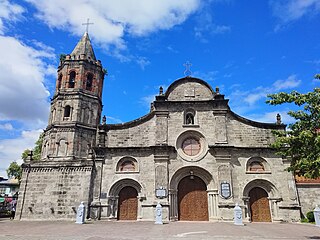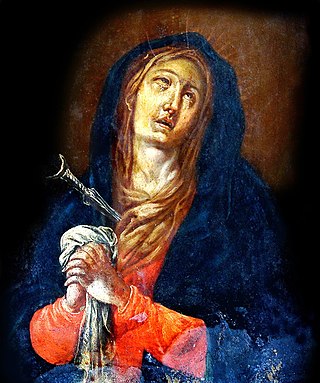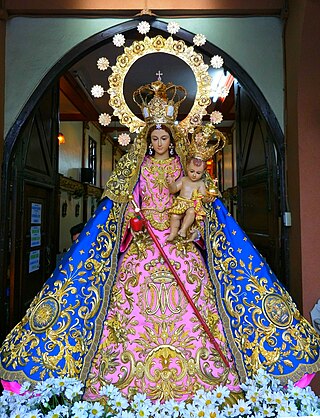
A shrine to the Virgin Mary, or Marian shrine, is a shrine marking an apparition or other miracle ascribed to the Blessed Virgin Mary, or a site on which is centered a historically strong Marian devotion. Such locales are often the destinations of Christian pilgrimages.

According to apocrypha, as well as Christian and Islamic tradition, Saint Anne was the mother of Mary, the wife of Joachim and the maternal grandmother of Jesus. Mary's mother is not named in the Bible's canonical gospels. In writing, Anne's name and that of her husband Joachim come only from New Testament apocrypha, of which the Gospel of James seems to be the earliest that mentions them. The mother of Mary is mentioned but not named in the Quran.

Bulacan, officially the Province of Bulacan, is a province in the Philippines located in the Central Luzon region. Its capital is the city of Malolos. Bulacan was established on August 15, 1578, and part of the Metro Luzon Urban Beltway Super Region.

Taguig, officially the City of Taguig, is the fourth-most populous city in the Philippines with a population of 1.2 million people. The city is located alongside the northwestern shores of Laguna de Bay in Metro Manila, Philippines. Taguig is known for Bonifacio Global City, one of the leading financial centers of the Philippines. Originally a fishing village during the Spanish and American colonial periods, it experienced rapid growth when former military reservations were converted by the Bases Conversion and Development Authority (BCDA) into financial centers and mixed-use planned communities. Taguig became a highly urbanized city with the passage of Republic Act No. 8487 in 2004, which was ratified by a plebiscite.

Santa Ana, officially the Municipality of Santa Ana, is a 3rd class municipality in the province of Pampanga, Philippines. According to the 2020 census, it has a population of 61,537 people.

Santa Cruz is a district in the northern part of the City of Manila, Philippines, located on the right bank of the Pasig River near its mouth, bordered by the districts of Tondo, Binondo, Quiapo, and Sampaloc, as well as the areas of Grace Park and Barrio San Jose in Caloocan and the district of La Loma in Quezon City. The district belongs to the 3rd congressional district of Manila.

The Minor Basilica and National Shrine of Jesus Nazareno (Black Nazarene), popularly known as Quiapo Church and canonically as the Saint John the Baptist Parish, is a prominent basilica in the district of Quiapo in the city of Manila, Philippines. It is the home of the Black Nazarene, a dark statue of Jesus Christ said to be miraculous. The basilica is under the jurisdiction of the Archdiocese of Manila under the Vicariate of José de Trozo and its current rector is Rufino C. Sescon, Jr.

Dambana ng Kawayan, officially known as Saint John the Baptist Parish, is a Roman Catholic parish church located in Barangay Ligid-Tipas in Taguig, Philippines.

Our Lady of Sorrows of Turumba is a Roman Catholic Marian title of the Blessed Virgin Mary a venerated Marian icon and image associated to the Our Lady of Sorrows, The town of Pakil in the province of Laguna considers her as its patroness.

The Virgin of Candelaria or Our Lady of Candle (Tagalog: Mahal na Birhen ng Candelaria, popularly called La Morenita, celebrates the Virgin Mary on the island of Tenerife, one of the Canary Islands. The center of worship is located in the city of Candelaria in Tenerife. She is depicted as a Black Madonna. The "Royal Basilica Marian Shrine of Our Lady of Candelaria" is considered the main church dedicated to the Virgin Mary in the Canary Islands and she is the patroness saint of the Canary Islands. Her feast is celebrated on February 2 and August 15, the patronal feast of the Canary Islands.

The Immaculate Conception Cathedral of Pasig, commonly known as the Pasig Cathedral is a Roman Catholic church located in Plaza Rizal, Barangay Malinao, Pasig in Metro Manila, Philippines. It is the mother church, and the episcopal seat of the Diocese of Pasig and one of the oldest structures in the city.

The Metropolitan Cathedral of Saint Elizabeth of Hungary, also known as the National Shrine of Our Lady of the Candles and colloquially as Jaro Cathedral, is a cathedral located in the district of Jaro in Iloilo City, on the island of Panay in the Philippines. The seat of the Roman Catholic Archdiocese of Jaro, it was placed under the patronage of Saint Elizabeth of Hungary. It was established in 1575 as a visita (chapel-of-ease) of Oton by the Augustinians and as a separate parish in 1587. The present-day structure of Jaro Cathedral was built in 1874.

The Diocesan Shrine and Parish of Our Lady of Light, popularly known as Cainta Church, is a Roman Catholic parish church located along Andres Bonifacio Avenue in Barangay San Andres, Cainta, Rizal, in the Philippines. The church also operates a neighboring school, Cainta Catholic College. From its time of erection as a parish in 1760 until 1983, it belonged to the Archdiocese of Manila. It was placed under the newly created Diocese of Antipolo in 1983, which is now headed by Ruperto C. Santos. It belongs to the Vicariate of Our Lady of Light.

The National Shrine of Our Lady of the Abandoned, also known as the Santa Ana Church, is a Spanish colonial period church located in the district of Santa Ana in Manila, Philippines. The parish was established by the Franciscan missionaries in 1578 under the patronage of Saint Anne. The present stone church was constructed by Vicente Inglés from 1720 to 1725 and was dedicated to its present patron, the Our Lady of the Abandoned. The revered image of its patron was made in Valencia, Spain in 1713 and arrived in the Philippines in 1717.
The Saint Anne Parish and Diocesan Shrine, also known as Saint Anne Parish, is a Roman Catholic church located in Silangang Malicboy in the municipality of Pagbilao, Quezon, Philippines. The parish's patroness is Saint Anne.

Our Lady of Aránzazu and is a Roman Catholic title of the image of the Blessed Virgin Mary venerated in San Mateo, Rizal, Philippines.

Santa Ana is one of the 38 barangays of Taguig, Metro Manila, Philippines. It is one of the nine original barrios of Taguig. It is named after Saint Anne, who is the patroness of the barangay.

The Basilica Minore de San Pedro Bautista, also known as the San Francisco del Monte Church and alternatively as Santuario de San Pedro Bautista, is a minor basilica and parish church in the San Francisco del Monte district of Quezon City, Philippines. It is one of the oldest churches in the country and the oldest in the city, having been founded in 1590. The church is dedicated to its founder Padre Pedro Bautista, a Spanish missionary from Ávila, Spain, one of the 26 Christians martyred in Japan in 1597.






















